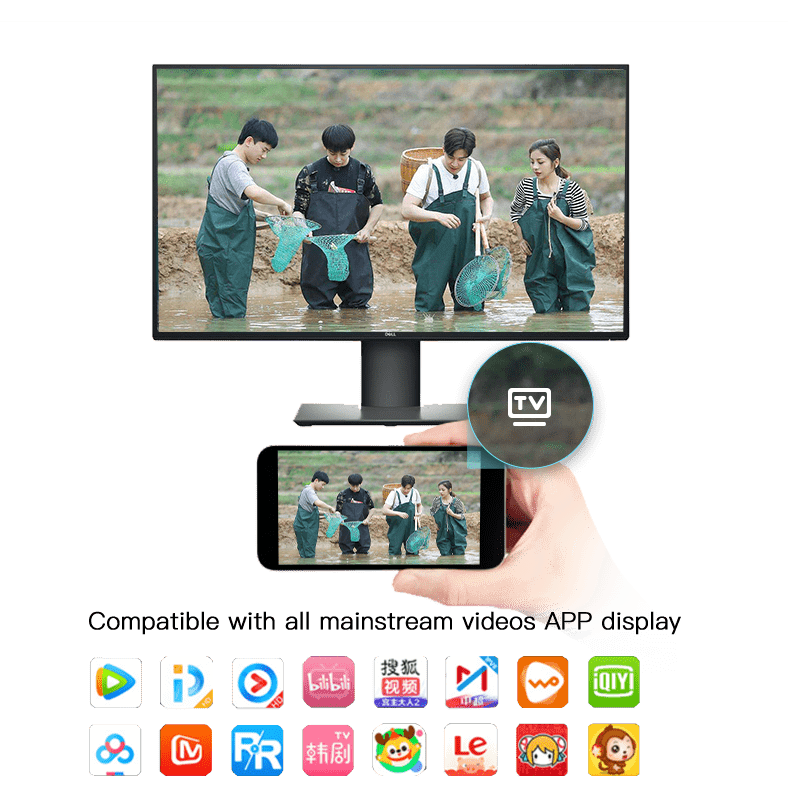What are the five wireless screen projection technologies?
Wireless screen projection refers to the smart mobile device client to display the screen image and sound of the machine on another display device through WIFI, so as to achieve the same screen display. With the rapid development of business screen projection technology, there are more and more electronic products that support screen projection. What are the implementation technologies of wireless screen projection?
Today, Xiaobian will take you to the system to understand the five wireless screen technology.

1.AirPlay screen mirroring
Airplay is a wireless technology unique to Apple devices. Through WiFi connection, we can project pictures, videos and other information on iOS devices such as iPhone and iPad to devices that support AirPlay through wireless transmission. Since Apple devices do not allow third-party programs to obtain their screen images, many domestic wireless projection boxes are achieved by cracking the AirPlay protocol.
The operation mode of screen projection is very simple, if you are an Apple phone, swipe up at the bottom of the screen with your finger, call out the detailed panel of the control center, click “Screen image” → Select devices → Screen projection. Apple’s ipad also uses a “screen image” to project the screen, but the control center is located at the bottom of the screen and in the upper right corner of the screen.
It is worth reminding that the screen projection through AirPlay screen image needs to ensure that the Apple device and the screen projector are in the same LAN (same network segment), and cannot be used across network segments and vlans, which is more troublesome for enterprises with a responsible network architecture.
2.Miracast multi-screen interaction
Miracast is the Wi-Fi Alliance’s authentication name for devices that support Wi-Fi Display. Miracast projection technology is mainly used on two types of devices:
(1) Some Android phones that support multi-screen interaction
Android5.0 and above mobile phones usually come with Miracast screen projection protocol, through the internal Settings of the phone can achieve wireless display, without installing any software, without any network support.

(2) Windows 8/10 computers
Windows 8/10 PC native support of WiDi protocol based on Miracast protocol improvement, no need to install any software can directly screen projection.
However, Miracast has two shortcomings that limit its use in demanding situations. First, the bottom layer is UDP transmission protocol, the transmission process is unreliable, easy to be interfered with, will lead to the receiving end of the screen; Second, the Miracast opening method designed by each Android device manufacturer is inconsistent, resulting in unified training and large-scale promotion.
3.DLNA push
The full name of DLNA is the DIGITAL LIVING NETWORK ALLIANCE(Digital Living Network Alliance), which aims to solve the connectivity of mobile devices and consumer appliances. DLNA projection is often used in combination with Miracast. Because Miracast is a mirror projection, the image is damaged. The DLNA screen projection adopts the so-called push mode, which essentially pushes the content on the mobile phone to the large screen (TV or projector) in the form of a URL for playback. This method ensures that the picture quality is lossless and has certain requirements for the network, but there is no picture at the transmitter end, which is mostly used for home theater use and is not suitable for enterprises.

4. Private screen projection protocol
Generally, screen equipment manufacturers will have their own customized private screen projection protocols, such as BJcast protocol, which is a private screen projection protocol developed by Betjie Internet.
Suzhou Bijie Network Co., LTD. (hereinafter referred to as Bijie) is a leading enterprise intelligent office, intelligent education products and solutions provider, committed to wireless screen, multi-screen interaction and rich intelligent office, intelligent education products to help enterprises and education customers improve office learning efficiency, solve communication management problems, make everything easier.
5. Wireless projection mode of HDM transmitter
HDMI transmitter wireless screen projection mode, that is, the HDMI transmitter directly from the transmitter HDMI output interface to obtain screen projection information, compressed encoding after sending to the receiving end. There are two main protocols that use the screen projection method: one is the device that uses the WHDI protocol; The second is the device using the WirelessHD protocol. Its disadvantages are also obvious, many transmitter devices do not have HDMI output, so it is not possible to use this way.
After reading this article, we should be able to understand the wireless screen projection technology to achieve the same screen interaction, Miracast, Airplay, DLNA, enterprise private screen projection protocol and HDMI in line screen technology five, then you are using is what kind of way?